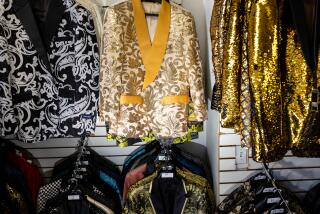Neckwear industry in knots as ties’ popularity wanes
Even though more out-of-work executives are on the interview circuit, neckties still can’t muster a comeback.
As the unemployment rate climbed to 10% last year, tie industry executives pinned their hopes on men buying ties to dress up their old suits. But that didn’t happen.
Instead, suit sales in the U.S. rebounded to end 2009 virtually unchanged from a year earlier, a marked improvement after years of decline.
Ties, on the other hand, had their worst year since the dawn of casual Fridays relegated neckwear to the back of the closet.
Given that tie fashion has changed little in the last decade, it’s hardly surprising that men are digging out old ties rather than buying new ones, said Marshal Cohen, a consumer behavior expert. At least a dozen ties hang in the typical man’s closet, Cohen said. He adds that men used to be able to count on getting new ones every birthday or Father’s Day.
“Men don’t throw away their ties,” said Cohen, chief industry analyst at NPD Group. “They collect them without trying.” The number of ties sold in the U.S. fell 18% in 2009, to 29 million, more than double the 7.3% drop in 2008, according to NPD, a Port Washington, N.Y., market research firm. Revenue fell 16%, to $418 million, down from a peak of more than $1 billion in the mid-1990s, when power ties ruled.
Tie makers have been steadily losing customers since the dot-com bubble turned Dockers and polo shirts into standard office attire.
“No one wants to overdress,” said fashion expert Tom Julian, author of “Nordstrom Guide to Men’s Style.” “It’s very important to mirror the image of the company. I have had calls from [baby] boomers who are now going back out [on job hunts] and realize their power-suit look is too much. They need to fit in.”
It hasn’t helped that for the last two years, the necktie has been without an official advocate.
The Men’s Dress Furnishings Assn., the trade group representing tie makers, disbanded in 2008 after 60 years when membership dwindled to about two dozen companies. Neckties fell another notch when President Obama made wearing tie-less dress shirts and blazers fashionable.
Even Exelon Corp. Chairman and Chief Executive John Rowe, an old-guard Chicago businessman and stalwart wearer of ties, spoke without one at an electric industry financial conference in November.
Rowe told the audience that his advisor, Karie Anderson, Exelon’s vice president of investor relations, “solemnly assured me on Friday that I could wear a tie if I absolutely had to, but no one else would, and it would really be better if I didn’t.”
That’s not to say that men can go anywhere without a tie. At the Chicago Club, where businessmen have been dining for more than a century, general manager Frank Stover keeps a dozen ties on hand for men who arrive unprepared.
The private club, founded in 1869, bowed to the khakis-and-shirt movement in 1999 by creating a small area where casual dressers can have a bite to eat. But neckties remain mandatory at the main Grill Room and Lounge, where 80% to 90% of the diners sit.
“Tradition has a lot to do with it,” Stover said. “The board of the club still wants to see the dining room with jacket and tie for the members. There aren’t too many places now that require a tie.” Likewise, “Mad Men” protagonist Don Draper and pop star Justin Timberlake helped spark sales of skinny ties and slim suits among men in their 20s and early 30s.
But unlike the dark-suit-and-red-power-tie uniform of their baby boomer dads in the 1980s, 21st century men are mixing ties with cardigans and wearing jackets without ties. It is a regimen that calls for donning a tie now and then, but does little to revive mainstream neckwear sales.
“It’s not about wearing a tie five days a week,” said Gregg Andrews, Nordstrom’s Chicago fashion director. “I don’t think the tie is going to go that way.” Executive recruiter Peter Crist has been working with job-hunting executives for more than 30 years and said it is a rare day when he encounters a client in a tie.
“Every meeting I go to it seems my counterpart is tie-less,” Crist said. “It could be a CEO, a board member, a job candidate. Inevitably, I walk into a company and I’m the only person in the lobby who has a tie on.”
Tie maker Greg Shugar blames part of the tie’s downfall on prices. In 2004 he opened an online store called TheTieBar.com that sells silk ties for $15 each.
The business took off as the recession settled in and the market for $120 silk ties waned, along with $900 handbags and $500 shoes. His sales got an extra kick last year after GQ magazine mentioned TheTieBar.com in an August fashion spread. Lately, Shugar has been lobbying to restart a neckwear trade group and launch a marketing campaign to promote the tie. So far, he has been unable to rally much enthusiasm.
“Until the neckwear industry bands together and promotes the idea that we should be dressing up at work again, this is going to continue to be a problem,” Shugar said. “We need to take the necktie tradition and modernize it and not desert it.”
More to Read
Inside the business of entertainment
The Wide Shot brings you news, analysis and insights on everything from streaming wars to production — and what it all means for the future.
You may occasionally receive promotional content from the Los Angeles Times.










